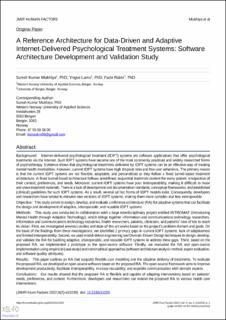| dc.description.abstract | Background:
Internet-delivered psychological treatment (IDPT) systems are software applications that offer psychological treatments via the internet. Such IDPT systems have become one of the most commonly practiced and widely researched forms of psychotherapy. Evidence shows that psychological treatments delivered by IDPT systems can be an effective way of treating mental health morbidities. However, current IDPT systems have high dropout rates and low user adherence. The primary reason is that the current IDPT systems are not flexible, adaptable, and personalized as they follow a fixed tunnel-based treatment architecture. A fixed tunnel-based architecture follows predefined, sequential treatment content for every patient, irrespective of their context, preferences, and needs. Moreover, current IDPT systems have poor interoperability, making it difficult to reuse and share treatment materials. There is a lack of development and documentation standards, conceptual frameworks, and established (clinical) guidelines for such IDPT systems. As a result, several ad hoc forms of IDPT models exist. Consequently, developers and researchers have tended to reinvent new versions of IDPT systems, making them more complex and less interoperable.
Objective:
This study aimed to design, develop, and evaluate a reference architecture (RA) for adaptive systems that can facilitate the design and development of adaptive, interoperable, and reusable IDPT systems.
Methods:
This study was conducted in collaboration with a large interdisciplinary project entitled INTROMAT (Introducing Mental Health through Adaptive Technology), which brings together information and communications technology researchers, information and communications technology industries, health researchers, patients, clinicians, and patients’ next of kin to reach its vision. First, we investigated previous studies and state-of-the-art works based on the project’s problem domain and goals. On the basis of the findings from these investigations, we identified 2 primary gaps in current IDPT systems: lack of adaptiveness and limited interoperability. Second, we used model-driven engineering and Domain-Driven Design techniques to design, develop, and validate the RA for building adaptive, interoperable, and reusable IDPT systems to address these gaps. Third, based on the proposed RA, we implemented a prototype as the open-source software. Finally, we evaluated the RA and open-source implementation using empirical (case study) and nonempirical approaches (software architecture analysis method, expert evaluation, and software quality attributes).
Results:
This paper outlines an RA that supports flexible user modeling and the adaptive delivery of treatments. To evaluate the proposed RA, we developed an open-source software based on the proposed RA. The open-source framework aims to improve development productivity, facilitate interoperability, increase reusability, and expedite communication with domain experts.
Conclusions:
Our results showed that the proposed RA is flexible and capable of adapting interventions based on patients’ needs, preferences, and context. Furthermore, developers and researchers can extend the proposed RA to various health care interventions. | en_US |

